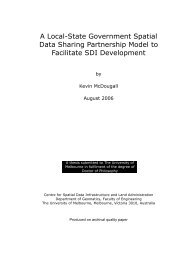Digital Lodgement of Cadastral Survey Data in Australia - Centre for ...
Digital Lodgement of Cadastral Survey Data in Australia - Centre for ...
Digital Lodgement of Cadastral Survey Data in Australia - Centre for ...
Create successful ePaper yourself
Turn your PDF publications into a flip-book with our unique Google optimized e-Paper software.
us<strong>in</strong>g this comb<strong>in</strong>ation <strong>of</strong> programs, it takes advantage <strong>of</strong> the <strong>in</strong>tegrated nature <strong>of</strong> data transfer, manipulation and calculation<br />
functions provided by this application’s environment.<br />
Queensland also have a surveyor accreditation scheme <strong>in</strong> place, whereby only 10% <strong>of</strong> plans lodged are exam<strong>in</strong>ed <strong>for</strong> quality<br />
assurance, with the rema<strong>in</strong>der passed without check<strong>in</strong>g. This has dramatically reduced the plan assessment workload, however<br />
it is considered that the <strong>in</strong>troduction <strong>of</strong> digital lodgement would also assist <strong>in</strong> automat<strong>in</strong>g some <strong>of</strong> the assessment checks<br />
(Rush, 1997).<br />
Although there has been substantial work done <strong>in</strong> the area <strong>of</strong> digital lodgement <strong>in</strong> Queensland, Rush (1997) stated that <strong>in</strong> the<br />
absence <strong>of</strong> cadastral re<strong>for</strong>m, digital lodgement only provides a limited reduction <strong>in</strong> the total cadastral data process<strong>in</strong>g workload.<br />
He emphasised the need <strong>for</strong> complete cadastral re<strong>for</strong>m <strong>in</strong> order to provide the greatest benefits <strong>for</strong> both surveyors and the<br />
government (Rush, 1997).<br />
South <strong>Australia</strong><br />
The responsible authority <strong>for</strong> digital lodgement <strong>in</strong> South <strong>Australia</strong> is the Land Services Group (LSG), with<strong>in</strong> the Land<br />
Boundaries Branch. One <strong>of</strong> the ma<strong>in</strong> aims <strong>of</strong> the LSG is to develop an Electronic Plan <strong>Lodgement</strong> System, result<strong>in</strong>g <strong>in</strong> improved<br />
efficiency <strong>for</strong> both the surveyor and the Land Boundaries Branch, less work to amend mathematical errors on plans and<br />
surveys, and reduced exam<strong>in</strong>ation times (Land Services Group, 1997).<br />
The issue <strong>of</strong> digital lodgement first arose <strong>in</strong> 1991, where a work<strong>in</strong>g party was established to exam<strong>in</strong>e the feasibility <strong>of</strong> the<br />
proposal. However, the ma<strong>in</strong> conclusion was that there were not sufficient technological resources available (Land Services<br />
Group, 1997).<br />
<strong>Digital</strong> lodgement then became a prom<strong>in</strong>ent issue <strong>in</strong> the 1994/95 LSG Strategic Plan, where another work<strong>in</strong>g party was created.<br />
Part <strong>of</strong> this <strong>in</strong>cluded the distribution <strong>of</strong> a questionnaire to all surveyors and draftspersons who lodged surveys with LSG,<br />
seek<strong>in</strong>g their views on electronic plan lodgement. 73% <strong>of</strong> respondents <strong>in</strong>dicated support <strong>for</strong> the electronic lodgement <strong>of</strong> plans<br />
with the response clearly show<strong>in</strong>g a high level <strong>of</strong> technological awareness <strong>in</strong> the <strong>in</strong>dustry (Land Services Group, 1997).<br />
The ma<strong>in</strong> f<strong>in</strong>d<strong>in</strong>gs <strong>of</strong> the work<strong>in</strong>g party were that a plan would still be required, and that <strong>in</strong>itially electronic plan lodgement<br />
should only <strong>in</strong>volve capture <strong>of</strong> data shown on the face <strong>of</strong> the plan. In the long term, the LSG proposes to develop a system<br />
whereby the survey plan comprises two parts, the plan graphic and a disk conta<strong>in</strong><strong>in</strong>g the digital <strong>in</strong><strong>for</strong>mation extracted from the<br />
plan (Land Services Group, 1997). As stated by Kentish (1997), the LSG <strong>in</strong>tends to firstly capture the mathematical and survey<br />
mark <strong>in</strong><strong>for</strong>mation <strong>in</strong> a digital <strong>for</strong>m, and then later expand to <strong>in</strong>clude the key textual data. In the meantime, surveyors and clients<br />
will still require a hard copy plan, which <strong>in</strong> the future is envisaged to be lodged as an electronic image.<br />
Western <strong>Australia</strong><br />
The responsibility <strong>for</strong> the validation and registration <strong>of</strong> survey plans <strong>for</strong> both freehold and crown estates <strong>in</strong> Western <strong>Australia</strong><br />
resides with the Department <strong>of</strong> Land Adm<strong>in</strong>istration (DOLA) through its Land Titles Division (Cribb and Higham, 1995). As a<br />
result <strong>of</strong> a government re<strong>for</strong>m program <strong>in</strong> 1995, digital lodgement was <strong>in</strong>troduced <strong>in</strong> Western <strong>Australia</strong> <strong>in</strong> that year with all plans<br />
be<strong>in</strong>g lodged required to be accompanied by a digital record <strong>of</strong> the plan.<br />
Prior to the re<strong>for</strong>m, a great deal <strong>of</strong> time was spent on survey exam<strong>in</strong>ation as it was necessary to manually key <strong>in</strong> angles and<br />
distances to validate polygon areas and dimensions, which was viewed as a duplication <strong>of</strong> those processes already carried out<br />
by the surveyor. It was recognised that if survey firms could supply digital data, then the exam<strong>in</strong>ation process could be<br />
streaml<strong>in</strong>ed hence facilitat<strong>in</strong>g earlier update <strong>of</strong> the DCDB. <strong>Digital</strong> lodgement was seen to be a progressive step as many<br />
surveyors <strong>in</strong> WA had already been provid<strong>in</strong>g DOLA with digital files.<br />
The opportunity was there<strong>for</strong>e taken by DOLA to fully automate the digital lodgement <strong>of</strong> plans by surveyors. One <strong>of</strong> the results<br />
<strong>of</strong> the program was the development <strong>of</strong> the <strong>Cadastral</strong> <strong>Survey</strong> <strong>Data</strong> (CSD) <strong>for</strong>mat, which was designed to provide <strong>for</strong> data to be<br />
extracted from various exist<strong>in</strong>g <strong>for</strong>mats <strong>in</strong> the market place (Cribb and Higham, 1995). There were seven s<strong>of</strong>tware packages used<br />
<strong>in</strong> the private sector <strong>in</strong> WA, and <strong>of</strong> these, four have had successful CSD conversions written <strong>for</strong> them (Hyde, 1997). All survey<br />
plans lodged with DOLA (both Crown and freehold) must now be accompanied by a digital record <strong>of</strong> the plan on a floppy disk<br />
<strong>in</strong> the CSD <strong>for</strong>mat (Hyde, 1997).<br />
The digital data file is used <strong>in</strong> four different ways (Cribb, 1997):<br />
• <strong>for</strong> <strong>in</strong>itial track<strong>in</strong>g and lodgement <strong>of</strong> the plan;<br />
• <strong>for</strong> scaled plots <strong>for</strong> <strong>in</strong>itial <strong>in</strong>dex<strong>in</strong>g and f<strong>in</strong>al reflection on public plan;<br />
• <strong>for</strong> automatic adjustment <strong>of</strong> closures <strong>of</strong> each parcel; and







